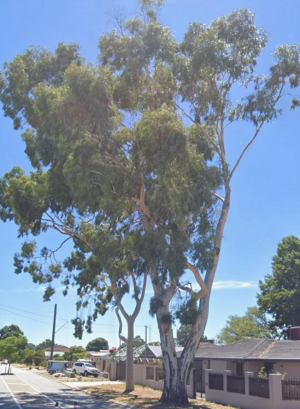Aussies can receive $200 annually for doing this good act
By
- Replies 10
In an era where urban expansion often threatens natural spaces, one council has introduced a new approach to safeguarding local greenery.
The recently approved initiative incentivises homeowners to preserve native trees on their properties.
The program aims to address concerns about diminishing canopy coverage while promoting long-term environmental benefits by offering a financial reward for each tree maintained.
'We're incentivising people to preserve significant trees on their own private property,' Mayor Patrick Hall explained during an interview.
Imagine the scenario: if a property owner has six qualifying large trees, they could pocket a tidy $1,200 each year, indefinitely, as long as the trees meet the established criteria.
The City of Canning is grappling with one of the lowest levels of tree canopy cover in Perth, with less than eight per cent.
This initiative is twofold; it aims to protect existing trees and to achieve an ambitious goal of planting over 60,000 new trees within the next two decades.
However, the decision to implement this plan wasn't without its dissenters. Mayor Hall himself cast the sole vote against the proposal.
His opposition wasn't rooted in arboreal aversion but rather in concerns over governance.
'There were just too many questions for me that were unanswered, about the potential cost of it, the legality of it,' he said.
One of Hall's primary worries is the potential for the scheme to disproportionately benefit the affluent, those who already enjoy the luxury of living amidst established, verdant blocks.
In contrast, it might not serve those in smaller, newer developments who are struggling to make ends meet.
Despite his reservations, as mayor, Hall respects the council's decision and supports the democratic process.
The plan stipulates that a registered tree cannot be removed without council approval.
Yet, it's still unclear what the ramifications would be if a property with a registered tree were to change hands.
'If an owner wanted to develop that property down the line and was hell-bent on removing those trees from the register, we have no idea whether or not it would be successfully defended by the city at court,' Hall admitted.
For a tree to be eligible for this payment, it must undergo an assessment to ensure it meets the strict criteria.
The tree must be significant, native, and typically large and old—qualities that the council deems worthy of preservation on private land.
Currently, all 165 trees on the register are situated on council land, in streets or parks, with none privately owned.
As Councillor Ben Kunze pointed out in a previous meeting, this hesitancy among property owners to register their trees may stem from concerns about the potential devaluation of their property.
This pioneering approach by the City of Canning could set a precedent for other councils across Australia and beyond, encouraging homeowners to participate actively in urban conservation.
It's a win-win situation: the environment benefits from the sustained presence of mature trees, and homeowners receive financial recognition for their stewardship.
So, for Aussie homeowners out there, it's time to look at your leafy companions not just as beautiful fixtures of your home but as potential contributors to your annual income.
 What do you think of this initiative? Could it work in your local area? Share your thoughts and experiences with us in the comments below.
What do you think of this initiative? Could it work in your local area? Share your thoughts and experiences with us in the comments below.
The recently approved initiative incentivises homeowners to preserve native trees on their properties.
The program aims to address concerns about diminishing canopy coverage while promoting long-term environmental benefits by offering a financial reward for each tree maintained.
'We're incentivising people to preserve significant trees on their own private property,' Mayor Patrick Hall explained during an interview.
Imagine the scenario: if a property owner has six qualifying large trees, they could pocket a tidy $1,200 each year, indefinitely, as long as the trees meet the established criteria.
The City of Canning is grappling with one of the lowest levels of tree canopy cover in Perth, with less than eight per cent.
This initiative is twofold; it aims to protect existing trees and to achieve an ambitious goal of planting over 60,000 new trees within the next two decades.
However, the decision to implement this plan wasn't without its dissenters. Mayor Hall himself cast the sole vote against the proposal.
His opposition wasn't rooted in arboreal aversion but rather in concerns over governance.
'There were just too many questions for me that were unanswered, about the potential cost of it, the legality of it,' he said.
One of Hall's primary worries is the potential for the scheme to disproportionately benefit the affluent, those who already enjoy the luxury of living amidst established, verdant blocks.
In contrast, it might not serve those in smaller, newer developments who are struggling to make ends meet.
Despite his reservations, as mayor, Hall respects the council's decision and supports the democratic process.
The plan stipulates that a registered tree cannot be removed without council approval.
Yet, it's still unclear what the ramifications would be if a property with a registered tree were to change hands.
'If an owner wanted to develop that property down the line and was hell-bent on removing those trees from the register, we have no idea whether or not it would be successfully defended by the city at court,' Hall admitted.
For a tree to be eligible for this payment, it must undergo an assessment to ensure it meets the strict criteria.
The tree must be significant, native, and typically large and old—qualities that the council deems worthy of preservation on private land.
Currently, all 165 trees on the register are situated on council land, in streets or parks, with none privately owned.
As Councillor Ben Kunze pointed out in a previous meeting, this hesitancy among property owners to register their trees may stem from concerns about the potential devaluation of their property.
This pioneering approach by the City of Canning could set a precedent for other councils across Australia and beyond, encouraging homeowners to participate actively in urban conservation.
It's a win-win situation: the environment benefits from the sustained presence of mature trees, and homeowners receive financial recognition for their stewardship.
So, for Aussie homeowners out there, it's time to look at your leafy companions not just as beautiful fixtures of your home but as potential contributors to your annual income.
Key Takeaways
- The City of Canning in Perth's southeast has approved a plan to pay homeowners $200 annually for each large, native tree they preserve on their properties.
- This initiative is part of efforts to address the area's low tree canopy cover and to incentivise the preservation of significant trees on private land.
- Concerns were raised by the mayor, Patrick Hall, about the governance of the scheme, its potential cost, and its impact on less wealthy residents.
- Trees must meet strict criteria to be eligible for registration and payment, and currently, no privately owned trees are on the register.








